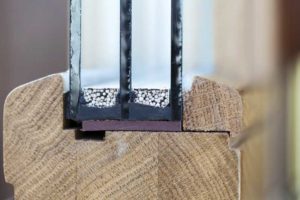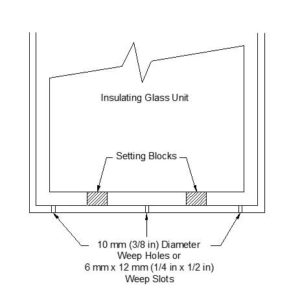Best practices for applying commercial IGU glazing

Gaskets should be sized longer than the length needed. If the gaskets are stretched during installation, they may return to their original length causing gaps at the corners.
Sponge or dense gasket systems may require special installation procedures to attain proper compression forces evenly distributed around the glass edge. The manufacturer should be consulted for proper procedures.
Structural gaskets
Structural gaskets, also called zipper gaskets or lock-strip gaskets, are pre-formed, cured elastomeric mechanical seals used to install glass or solid panels in a supporting framework. Made in two pieces, a main body that holds the glass or infill material in place and a wedge-like continuous locking strip is inserted into a recess in the main body, thus bringing pressure to bear upon the surface of the glass.
Some structural gasket systems use straight lengths of extruded gasket material, which can be cut to length and assembled in the field using an adhesive to join the corners. Most structural gasket systems, however, are pre-formed in the factory as continuous closed frames that are then joined in the field with an adhesive.

The gasket should be made at least one percent larger than the opening into which it is to be installed so it is under slight linear compression. The frame holding the gasket should be clean, smooth, and free of imperfections. Corner offsets of the frame should not exceed 1 mm (0.03 in.) and all frame joinery must be sealed.
Precise glass size and opening size are of critical importance when setting in framing members. Likewise, lip pressure and bite are extremely important in achieving weather-tightness. Consequently, close attention should be given to the framing, gasket, and glass tolerances.
Boot glazing
Boot glazing, also called wrap-around marine glazing material, is available in rolls or strips which wrap around the perimeter length of the IGU. As a common practice, the boot is clipped at the corner to fit. Framing members are pressed into position over the boot and then joined and fastened at the corners.
Since the boot wraps around the edge of the IGU, it often comes in direct contact with the IGU edge sealant. Therefore, compatibility should be checked. This often is verified through IGU fabricator or sealant manufacturer testing.

The boot is extruded as a continuous strip. Weep holes, a minimum of 10 mm (0.39 in.) in diameter, are essential and should be punched through the section that covers the bottom edge area of the IGU. They should be spaced at 100 to 150 mm (4 to 6 in.) on center around the perimeter of the IGU. Both the frame and boot systems’ weeping should be designed to adequately drain moisture from the system. Clipping the corners does not provide an adequate positive weep system. Setting blocks may have to be modified to suit the framing system while remaining suitable for their intended function.
Foam tapes are extruded closed-cell foam material of various densities and dimensions, normally packaged in rolls. A pressure-sensitive adhesive is applied to one or both sides of the foam tape. Proper compression of the foam tape and sealing of the cut and butt joint corners is necessary to achieve airtight and watertight seals. For more detailed information regarding correct usage of foam tapes, contact the foam tape manufacturers.
Glass type and thickness should be installation-specific, firmly supported and resist applicable loads based upon ASTM E1300, Standard Practice for Determining Load Resistance of Glass in Buildings, or ASCE/SEI 7, Minimum Design Loads and Associated Criteria for Buildings and Other Structures, as determined by code jurisdiction. Glass type and thickness can be determined using IGMA’s Glass Design computer program.









